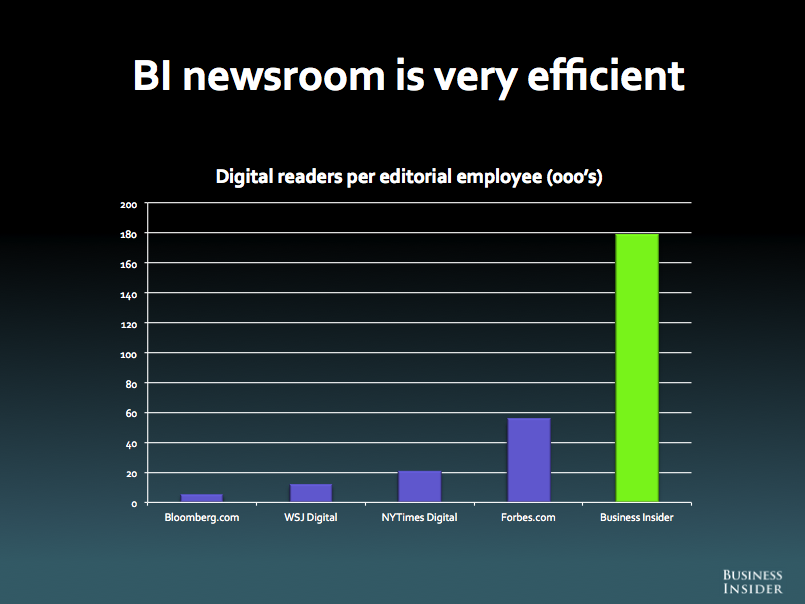
Much has been written over the past week about journalists’ favorite topic: the future of journalism. For once, it’s been about the business side of things, coming on the heels of Andrew Sullivan’s decision to strike out on his own with a subscription model and BuzzFeed’s most recent funding haul.
It’s useful to add to this discussion these pieces by Lewis DVorkin, chief product officer at Forbes, and Henry Blodget, CEO of Business Insider. Both men describe a future where the analog-dollars-to-digital-dimes equation is cemented. The idea of that gap closing, in a world of 4 trillion ad impressions, has moved beyond wishful thinking to pure fantasy. The question now for news publishers is what to do about it.
Paywalls, meters and subscriptions are one route. And yet in many cases, they’re treating the symptom and not the cause. I recently did an interview with Blodget on why he’s excited for the future of news. The main reason, as he outlines in his presentation, is algorithms can’t make stories — yet. Beyond that, there’s the simple fact that Business Insider has a vastly different cost base than a publication like Forbes. Out of Blodget’s 91 slides, this is the most instructive.
During our interview, I summed up his position as: Everyone’s screwed, but some are less screwed. The less screwed are publications that have gotten their cost structures in line with the new economics of digital media. Blodget likes his hand because he isn’t crating around enormous legacy costs like an old-school media company.
This isn’t lost on DVorkin. He’s engaged in restructuring Forbes, root and branch, from a lofty magazine for globe-trotting execs to something more like The Huffington Post for business. He calls this “entrepreneurial journalism,” where Forbes rents space out to dozens of contributors. Some of the content from these contributors is quite good. Much of it is dreck. That’s the price you pay nowadays, however, in a world where pageviews are king.
The pageview game is brutal. Once on that treadmill, it’s quite hard to get off. Advertisers can find their target audiences online without the publisher packaging together the wheat with the chaff. The “premium audiences” many publications have long touted are both easily found elsewhere cheaper. Again, 4 trillion ad impressions.
There’s one slide missing from Blodget’s open-kimono presentation: revenue and profit. There’s no way to know how truly successful this approach is without knowing that. TBI is undeniably a runaway hit in the pageview world. It is clearly a more efficient machine for generating pageviews than Forbes or the New York Times. Yet it’s hard to see the revenue per user equaling out. Blodget’s point to me is that the NYT will continue to get a premium, but that premium will come down, as its own execs have hinted in blaming programmatic ad buying on declining display rates. The bet then is that the publisher with the lower cost base will weather the storm the best. Forbes, with its editorial staff now numbering 1,000 contributors, is making a similar bet that it can churn out pageviews more cheaply and still command a premium in the market.
Cost bases are important but ultimately uninspiring. BuzzFeed, as The Wall Street Journal points out, is a decidedly old-school model. It is spending quite a bit on humans to create content, both editorial and advertising. With an edit staff of 70, BuzzFeed is betting on people ultimately. Make fun of its cute animal listicles all you want, but they’ve got more humanity than Google’s cold algorithms. Yes, content may no longer be king; this is the Age of Big Data, of course. There’s still room, however, for genuine creativity, particularly in advertising, a point that’s often lost in breathless citations of the latest hockey-stick graph of real-time bidding growth. Forbes and BuzzFeed are both betting on deep integrations with advertisers beyond what DVorkin calls “the box that sits in a silo adjacent to editorial.” The big hope is there will continue to be a market for smart, creative advertising outside of the machine-to-machine, mass commoditization media world.
Image via Shutterstock
More in Media

Media Briefing: The top trends in the media industry for 2025
This week’s Media Briefing takes a look at the top trends from 2025, from digital advertising revenue performance to AI licensing deals.

Digiday Scorecard: Publishers rate Big Tech’s AI licensing deals
Digiday has compiled a scorecard grading AI platforms to make sense of the growing number of players in the AI content licensing market.

Publishers are hunting for AI prompt data — now they’re starting to get it from third-party companies
Publishers are finally gaining some visibility into AI search, as new prompt data tools crack open a black box.






